|
|
|
Sort Order |
|
|
|
Items / Page
|
|
|
|
|
|
|
| Srl | Item |
| 1 |
ID:
167818


|
|
|
|
|
| Summary/Abstract |
China’s Belt and Road has been billed as the single most significant undertaking by the country on the international stage. In Africa, Kenya is a core part of both the Maritime Silk Road and the Belt. The authors have examined the flagship project of this initiative in Kenya, the Standard Gauge Railway (SGR) from the port of Mombasa to Nairobi, with a view to analyse the impact so far. Issues of employment, debt sustainability, neocolonialism and specific aspects of the project were looked at. Although our findings indicate that the SGR so far has both positive aspects as well as challenges, for the project to be successful both China and Kenya need to create a synergy towards solving concerns that have arisen from the completion of phase 1 of the project.
|
|
|
|
|
|
|
|
|
|
|
|
|
|
|
|
| 2 |
ID:
091728
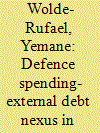

|
|
|
| 3 |
ID:
134401
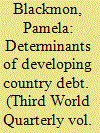

|
|
|
|
|
| Summary/Abstract |
Programmes designed to alleviate developing country debt have been implemented by bilateral, commercial and multilateral creditors and sovereign debt has been restructured under Paris Club negotiations. These strategies have not been very successful at reducing the debt levels of developing countries, in part because they continue to receive export credit insurance facilities through export credit agencies (ecas). The purpose of this paper is to examine the high percentages of developing country debt owed to governmental ecas. Analysis of the external debt of low-income and lower middle-income economies at five year intervals from 1980 to 2010 finds a substantial part of the indebtedness of these economies is held by ecas. Analysis of specific sub-Saharan African countries undergoing debt rescheduling and forgiveness through Paris Club negotiations was done for Ghana and Kenya. These results show that, following debt restructuring, new export credit guarantees and/or loans were forthcoming to these countries from the ecas of the creditor countries that rescheduled their old debt in Paris Club negotiations during 2000–12.
|
|
|
|
|
|
|
|
|
|
|
|
|
|
|
|
| 4 |
ID:
146509


|
|
|
|
|
| Summary/Abstract |
This paper investigates the effect of military spending on external debt in case of Pakistan for the period of 1973–2009. For this purpose, the autoregressive distributed lag bounds testing approach to cointegration is used to examine cointegration among the variables. The ADF, P-P, and ADF-GLS unit root tests are applied to test the integrating order of the variables. The Ordinary Least Square (OLS) and error correction method regressions are used to investigate the marginal impact of military spending on external debt in the long and short run. Our findings indicate the existence of cointegration that confirms the presence of a long-run relationship among military spending, external debt, economic growth, and investment. Further, our results reveal that a rise in military spending increases the stock of external debt; an increase in investment also increases external debt; however, there is an inverse effect of economic growth on external debt. An implication of the findings reported herein is that there is a need to formulate a comprehensive economic policy for curtailing external debt in case of Pakistan.
|
|
|
|
|
|
|
|
|
|
|
|
|
|
|
|
| 5 |
ID:
083236
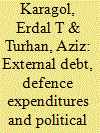

|
|
|
|
|
| Publication |
2008.
|
| Summary/Abstract |
This paper investigates the relationship between external debt, defence expenditures and political business cycles in Turkey for 1960-2002. Here, two important aspects of the political business cycle, the electoral effects and the partisan effects, were investigated. The empirical finding of impulse response functions of defence expenditures to a shock in the partisan effect is positive. The results reported here indicate that political colours of parties appear to be important. This suggests that defence expenditure is influenced by political ideology and the fiscal policy of governments after elections. Moreover, the impulse response functions of external debt stock to shocks to the electoral effects and the response of external debt stock shocks to the partisan effects increased over the whole period.
|
|
|
|
|
|
|
|
|
|
|
|
|
|
|
|
| 6 |
ID:
186162


|
|
|
|
|
| Summary/Abstract |
The fall of international oil prices by the mid-1980s and the associated economic downturn of the oil-rich countries of the Gulf represented a turning point in the economic history of Jordan, which has been historically dependent on international aid and workers’ remittances. Expansionary policies, failing to recognize the reduced inflow of external rent, led to an unprecedented rise in public debt. The situation culminated in 1989 in a deep financial crisis which induced Jordan to start a comprehensive economic reform program, inspired by the principles of the Washington Consensus. This study aims at investigating the emergence and main sources of Jordanian public debt, focusing on its external components. Based on archival research and interviews with experts, the study analyses the main reasons behind the rapid public debt increase in the second half of the 1980s and discusses its sustainability in relation to main creditor nations, negotiations with the donor community, conditionality of support, and implementation of reforms. The analysis reveals that before the 1989 crisis, there was no centralized management of public debt and debt was contracted to finance the needs of a bloated state apparatus and was not linked to comprehensive development strategies.
|
|
|
|
|
|
|
|
|
|
|
|
|
|
|
|
| 7 |
ID:
116305
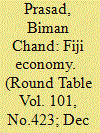

|
|
|
|
|
| Publication |
2012.
|
| Summary/Abstract |
Twenty-five years since the first military coup in 1987, Fiji continues to muddle through both politically and economically. The promise of a general election under a race-free constitution remains the fervent hope of all citizens. Economically the country continues to slide downwards, reflected in poor economic growth in 2010 and 2011. A poor level of private sector investment remains a feature of the macroeconomic picture, and it is unlikely to change for the foreseeable future. This article provides an overview of the Fiji economy and reflections on future prospects.
|
|
|
|
|
|
|
|
|
|
|
|
|
|
|
|
| 8 |
ID:
179959
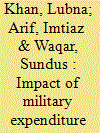

|
|
|
|
|
| Summary/Abstract |
This study aims to empirically test the effects of military expenditure on external debt of 35 arms importing countries by using the annual panel data from the year 1995 to 2016. The panel was divided into two income classes (upper-middle and lower-middle), and the basic sample was also divided into five different regions (Middle-East and North Africa, South and East Asia, Latin America, Europe and Central Asia, and Sub-Saharan Africa) to achieve further robustness in the study. The empirical results of pooled mean group estimators suggest that military expenditure generally increases the external debt burden in the studied countries. More specifically, it was noted that military expenditure decreases external debt in Europe and Central Asia. Moreover, it was found that the interaction term of military expenditure and growth rate is positive and significant in all of the sub-samples, except upper-middle class, the Middle East and North Africa, and Latin American regions. Thus, it may be concluded that military expenditure often increases external debt burden in countries where the debt management system is weak. Countries with weaker debt management systems need to devise economic policies that curtail their military expenditure, reduce their external debt and improve their economic condition.
|
|
|
|
|
|
|
|
|
|
|
|
|
|
|
|
| 9 |
ID:
087218
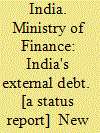

|
|
|
|
|
| Publication |
New Delhi, Ministry of Finance, Government of India, 1993.
|
| Description |
12p.
|
|
|
|
|
|
|
|
|
|
|
|
Copies: C:1/I:0,R:0,Q:0
Circulation
| Accession# | Call# | Current Location | Status | Policy | Location |
| 034968 | 336.54/IND 034968 | Main | On Shelf | General | |
|
|
|
|
| 10 |
ID:
050370


|
|
|
| 11 |
ID:
166742


|
|
|
|
|
| Summary/Abstract |
The damaging economic effects of the debt crises on Africa in the late 1980s encouraged considerable research on the determinants of external debt in developing economies. Although sub-Saharan Africa's (SSA) debt was cut by two-thirds by 2008, through two debt relief programmes, debt in the region has since been rising at an increasingly rapid pace. This study provides an empirical analysis of the determinants of external debt in SSA over the period 1960–2016, using dynamic panel methods. It also considers two potentially important factors that have received relatively little attention. One is military spending, rarely considered, despite a number of well-publicised scandals over the procurement of unnecessary and expensive high-tech weapons systems. A second, is the possibility that the countries studied have been involved in conflict. The empirical results point to a positive impact of military spending on external debt, but with some evidence of heterogeneity across the countries. Furthermore, findings indicate that the positive effect of military expenditure on debt becomes more marked in countries that have been affected by conflict. These results imply that policies to improve security and reduce military spending could be beneficial in reducing external debt and, potentially, improving economic performance in the region.
|
|
|
|
|
|
|
|
|
|
|
|
|
|
|
|
| 12 |
ID:
072645
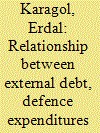

|
|
|
|
|
| Publication |
2006.
|
| Summary/Abstract |
This paper extends the Looney and Frederiksen (1986) study and investigates the relationship among external debt, defence expenditures and GNP in Turkey for 1960-2002. After applying cointegration analysis of a multivariate system of equations, impulse response functions and variance decomposition are estimated. The impulse response functions indicate that defence expenditures have a positive effect on external debt stock. Moreover, impulse response of GNP to defence expenditures tended to hike slightly within two years ahead, and dipped sharply by two years, and thereafter continued at a positive level.
|
|
|
|
|
|
|
|
|
|
|
|
|
|
|
|
|
|
|
|
|